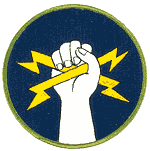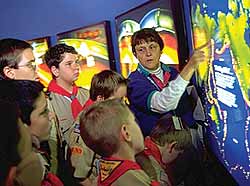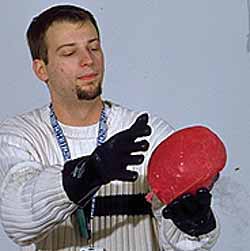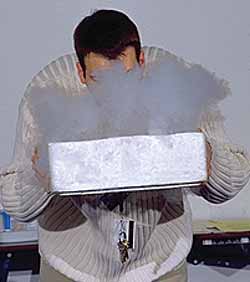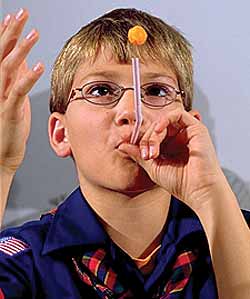![]() May - June 2003
May - June 2003
Partnerships for Learning
By Suzanne Wilson
Photographs By John R. Fulton Jr.
Merit badge clinics and Webelos Scout workshops presented at the St. Louis Science Center are two examples of the many BSA advancement resources available in the Gateway City.
- 'It Was Really Fun'
- Community Resources Enrich Scouting for Boys at Each Level
- Planning Merit Badge Skill Centers
- Science Can Be Fun
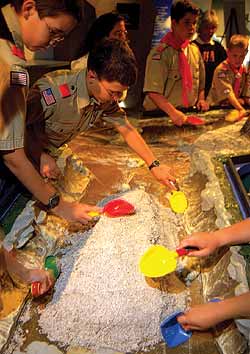 Scouts working on the Geology merit badge study the effects of erosion by constructing landscapes and then flooding the basin with water. |
This is serious business. Two groups of Boy Scouts working at the stream table at the St. Louis Science Center are creating landscapes they hope will survive the destruction of flowing water.
It's also engrossing fun. With small shovels, they move wet plastic "sand," sculpting valleys and mountains, and they add plastic rock formations for support.
"Where's the best place to put a house?" asks Elisabet Head, geologist and leader of the center's Ecology and Environment Gallery. The Scouts position buildings and trees.
When Head turns on the water, it slowly meanders from both ends of the table. Valleys fill and sand begins to move. "We had this perfectly planned," says Nathan Hillison, 12, from Troop 38 in Troy, Ill.
Later, when the Scouts return to the scene, houses at one end have toppled, and hills and trees have been washed away. At the other end, houses remain high on a mountain that held up to the power of water. Head calls it "10 years of erosion right before your eyes."
Hands-on lessons
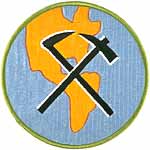
This hands-on lesson is part of the Geology merit badge instruction offered by the St. Louis Science Center, one of many community resources that help with Scout advancement. With special equipment, exhibits, and expertise, these places provide outstanding learning experiences for Scouts. (See sidebar for more examples.)
This Saturday morning session has attracted Scouts, leaders, and parents from the Greater St. Louis Area Council and Trails West Council in Illinois. Most of the Scouts are familiar with the center's lively atmosphere and exhibits that invite kids to experiment, but today is all about geology.
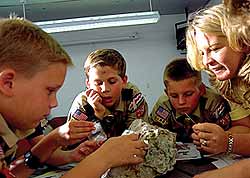 Pack 250 Webelos Scouts Clint Brown, Alex Hunt, Stephan Wibbenmeyer, and assistant den leader Bonnie Schnurbusch examine gold-colored crystals growing on top of a large rock. |
"I want to be an archaeologist," explains Colin Rohde, 11, from Troop 646 in St. Louis. "I want to learn what type of rocks I might go through."
The two-hour skill session, based on the Geology merit badge pamphlet (BSA No. 33284), is led by Elisabet Head. The Scouts have been to Missouri places she talks about in a classroom session: Johnson's Shut-Ins State Park, where they've seen the Black River plummeting over smooth volcanic rocks, and Elephant Rocks State Park, where they've walked among hulking, rounded granite boulders.
They open kits containing unmarked rocks and minerals and try to match them to cards that describe them. To solve this geological mystery, they test the specimens with small tools. Hematite, containing iron, attracts a magnet. Obsidian, which comes from a volcano, scratches glass.
Questions and answers
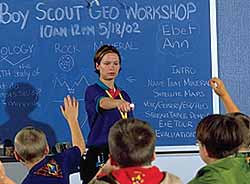 Geologist Elisabet Head asks boys questions about earthquakes, geysers, and volcanoes. |
The center's philosophy is to teach by asking questions, and these Scouts are quick to tell Head what they know about earthquakes, geysers, and volcanoes. In the Ecology and Environment Gallery, they view a seismograph in action and displays of the Earth's interior, plate tectonics, an ocean that once covered Missouri, and much more.
Head explains everything, adding to their understanding of earth processes.
Beside a video of fiery volcanoes, she shows the Scouts the sole of the boot she's wearing. During her internship in volcanology at Hawaii Volcanoes National Park, pieces of the tread broke away as she explored flow fields of solidified, spiky lava. On another pair of boots, she says, the tread melted when she walked on extremely hot, freshly hardened lava.
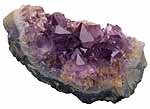
Jim Hoggatt of Troy, Ill., attending with his 12-year-old son Eric from Troop 226, says, "This is a good introduction to geology, and it's a great opportunity for them to get an exposure to an expert in the field who has had some experience."
It's also one-stop shopping, because Head is also a merit badge counselor. With all requirements completed, she signs each Scout's Geology merit badge certificate.
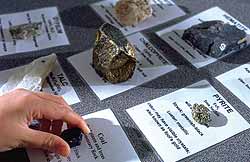 Scouts use a variety of tools and methods, including Mohs hardness scale and a magnet, to match a selection of unidentified rocks and minerals with their proper name card. |
Besides today's sessions, which include a Scientist activity badge workshop for Webelos Scouts, the St. Louis Science Center offers the Astronomy merit badge (in two sessions plus an outdoor "star party") and the Geologist activity badge.
The center's mission is: "To stimulate interest and understanding of science and technology throughout the community."
For these Scouts, on this day, the mission was accomplished.
Contributing editor Suzanne Wilson lives in Joplin, Mo. In Scouting's January-February issue, she profiled five women who have found satisfying and successful careers in professional Scouting.
'It Was Really Fun'At the end of each workshop at the St. Louis Science Center, Scouts en-ter their brief comments on evaluation cards. From the Geology merit badge session:
From the Scientist activity badge session:
|
Community Resources Enrich Scouting for Boys at Each LevelSeveral categories of community resources active in Scouting advancement in the St. Louis area may also be available in other communities. Programs can be designed to either partially or wholly complete requirements for a badge.
Museums And Other AttractionsThe Magic House, St. Louis Children's Museum, offers after-school workshops for Bear and Webelos Cub Scouts. 
At the St. Louis landmark Gateway Arch, National Park Service rangers present advancement opportunities for both Cub Scouts and Boy Scouts. The Butterfly House invites Boy Scouts to open-house lab sessions twice a year. The Worldways Children's Museum offers a Citizenship in the World merit badge fair.
Businesses And UtilitiesAmeren UE, an electric utility, hosts the Electricity merit badge. Gateway Country presents the Computers merit badge at three store locations in St. Louis.
Sports FacilitiesClayton Speed Skating Club holds a six-session Skating merit badge skill center in January and February at Clayton Shaw Park Ice Rink.
ExhibitionsSt. Louis Stamp Expo sponsors the Stamp Collecting merit badge each year. Council volunteers guide the skill center activities.
Colleges, UniversitiesTyson Field Science Program at Tyson Research Center of Washington University in St. Louis offers Webelos Scouts Geologist and Naturalist activity badge sessions, plus various achievement requirements for Wolf and Bear Cub Scouts.
State, County AgenciesMissouri Department of Conservation sets up stations on a fall Saturday that satisfy a variety of requirements for Wolf, Bear, and Webelos Scouts. St. Louis County Parks and Recreation Department sponsors a fall Cub Scout Advancement Day that includes numerous sessions for completing outdoor requirements for Wolf, Bear, and Webelos Scouts. |
Planning Merit Badge Skill CentersWhile many advancement events and activities are organized and conducted by Scouting volunteers, a council can expand its advancement opportunities by working with community institutions, organizations, and businesses.
Institutions such as the St. Louis Science Center or the Worldways Children's Museum (which hosts a Citizenship in the World merit badge fair) provide a public service by offering an advancement event. They also can develop new relationships with Scouts and their families, who may return for additional educational, recreational, or business purposes. All new skill centers must have their plans approved by the council advancement committee, says Fred Brown, director of training and advancement for the Greater St. Louis Area Council. "I talk with them about the things they need to do. We go over the merit badge requirements and make sure they understand them and what we expect." New merit badge counselors also must be approved by the committee. In planning a science center workshop program, Brian Schaffer, manager of public and special programs at the St. Louis Science Center, starts by looking at the BSA's most popular merit badge pamphlets in the science area. "Some things are too in-depth, and there's no way we could fit them into a two-hour workshop," he notes. "We look at the requirements and see what we can do in a classroom and what we can use in the gallery." —S.W. |
Science Can Be Fun
In the afternoon, a Scientist activity badge session for Webelos Scouts begins with a genuine blast. Brian Hostetler, a gallery assistant and education major at the University of Missouri-St. Louis, leads everyone through the Exploradome, a huge structure made of thick vinyl and held up by air pressure. They walk outdoors through an air lock and wait before another door in the dome. When it suddenly opens outward, the kids yell in surprise as a powerful surge of air pressure rocks them on their heels. "My goal is to teach kids not just the science concepts, but how science can be fun," says Hostetler. Back in the classroom, he puts on a veritable magic show at a safe distance from the audience. When he pours super-cold liquid nitrogen over an inflated red balloon, it crumples. Why? Scouts guess: "It's melting." "It's deflating." "It's contracting," says Padrick Mulligan, 10, from Pack 72 in Edwardsville, Ill.
"I love the c-word," says Hostetler. "All the air is still in there. It's extremely cold, and it's contracting. The air inside takes up less space; the air pressure is lowered. The atmospheric pressure from outside pushed it down." The kids get in on the act with Bernoulli's principle, which says the pressure of moving gas or liquid decreases as its speed increases. [See the Webelos Scout Book (BSA No. 33108), pages 300-302.] Each Webelos Scout gets a "bendy straw" and one lightweight, spherical, cheese snack food. If he can blow a constant stream of air through the straw, the cheese ball will hover above the straw's upturned end. The Webelos Scout's breath, quickly moving along the ball's sides, has less pressure than the calmer air of the room. The ball is constantly pushed into the center of the air stream by the higher pressure of the surrounding air.
"Oh, cool," says Bonnie Schnurbusch, snapping photos. She and Jill Hunt, den leaders from Pack 250, Perryville, Mo., plan their meetings around activity badges, but they knew this science session was made for them. "If you don't have a science background, it's difficult to come up with examples," Hunt says. "And this is a nice change of pace." Center of gravity, optical illusions, Newton's laws of motion—Hostetler and assistant Ann Schafer take the Webelos Scouts through the Scientist activities, with plenty of audience participation and humor. "I like Newton," Hostetler jokes. "He's not a cookie; he's fruit and cake." The session ends with free time in the Human Adventure Gallery, where Webelos Scouts disappear into its maze of interactive wonders. Jacob Krauss, a second-year Webelos Scout with Pack 2 in Bunker Hill, Ill., clowns at a mirror that makes him appear to have extra arms and legs. Den leader Jeff Seyer, Pack 72, Edwardsville, Ill., pauses with his Scouts at the "Conduct Yourself" exhibit, where they move their hands over a flat surface to alter the pitch and volume of an electronic instrument called a theremin. —S.W. |
May-June 2003 Table of Contents
Copyright © 2003 by the Boy Scouts of America. All rights thereunder reserved; anything appearing in Scouting magazine or on its Web site may not be reprinted either wholly or in part without written permission. Because of freedom given authors, opinions may not reflect official concurrence.
| The Boy Scouts of America | http://www.scouting.org |
